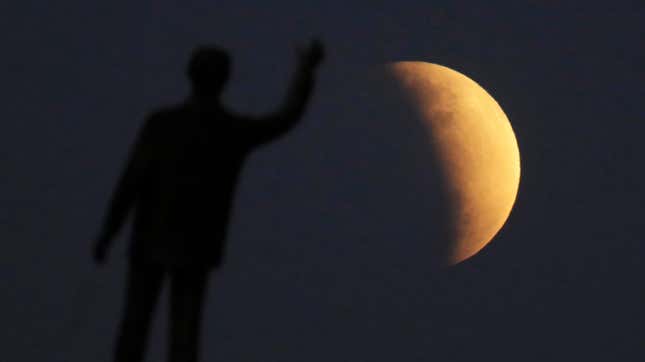
It may not be a total lunar eclipse, but the partial lunar eclipse happening November 19 promises to be spectacular owing to the large amount of shade our planet will cast onto the Moon and its unusually long duration.
The lunar eclipse on November 19 may be partial, but around 97% of the Moon will be darkened by Earth’s shadow at peak, so it promises to be a sublime experience. The affected part of the Moon should appear reddish-brown, in addition to being discernibly dimmer overall. The peak of the eclipse will occur at 4:03 a.m. ET on Friday, November 19, but Earth’s shadow will be visible for three hours before and after that moment.
“With a just thin sliver of the moon exposed to direct sun at maximum eclipse, the rest of the moon should take on the characteristically ruddy colors of a total lunar eclipse,” as EarthSky reports.
Another cool thing about this partial lunar eclipse is its duration. The penumbral eclipse, in which the Moon passes through both the inner and outer portions of the Earth’s shadow, will last for 6 hours and 1 minute, while the umbral eclipse, or the casting of the inner shadow, will last for 3 hours and 28 minutes, according to NASA. The Moon will be near apogee (i.e. the Moon’s furthest distance from Earth along its orbit) during the partial lunar eclipse, hence the extended astronomical show.
EarthSky says the upcoming lunar eclipse will be the longest since February 18, 1440 (seems like just yesterday) and that another of this extreme duration won’t happen again until February 8, 2669 (mark your calendars). That’s a stretch of 1,229 years, so keep that in mind if you’re on the fence about waking up early.

On that topic, the partial lunar eclipse of November 19 will be visible across much of the globe, including the Americas, eastern Asia, Australia, and the Pacific Region. For observers in North America, the show will start shortly after 2:00 a.m. ET (for observers on the U.S. West Coast, that means 11:00 a.m. PT on November 18), with the peak happening just after 4:00 a.m. ET, NASA says.
The lunar eclipse won’t be visible to observers in Africa, the Middle East, or western Asia, but not to worry—lunar eclipses tend to happen about twice a year. What’s more, a total lunar eclipse is expected the evening of May 15, 2022.
More: Holy Crap, the Moon Was Struck by a Meteorite During the ‘Super Wolf Blood Moon’ Eclipse.